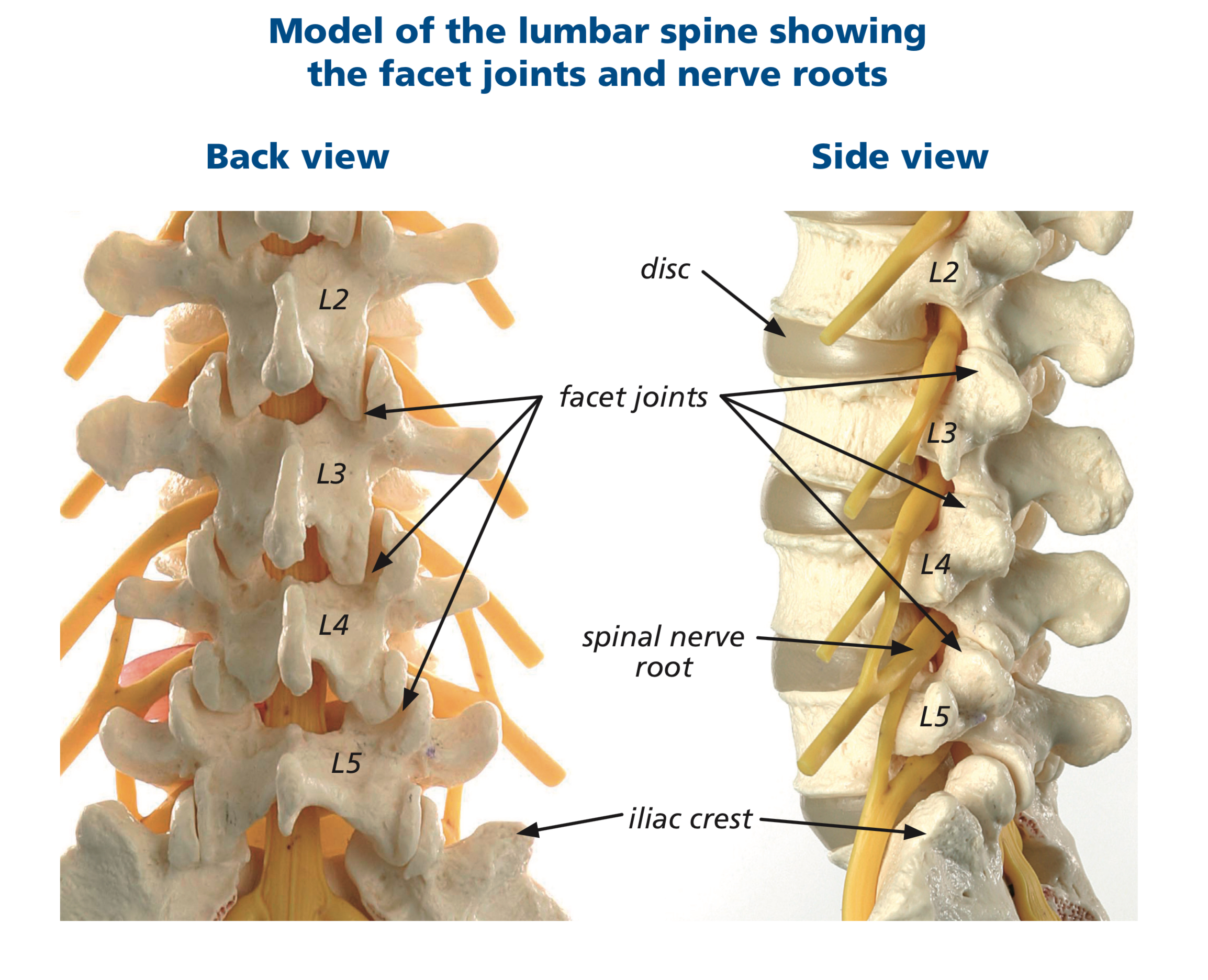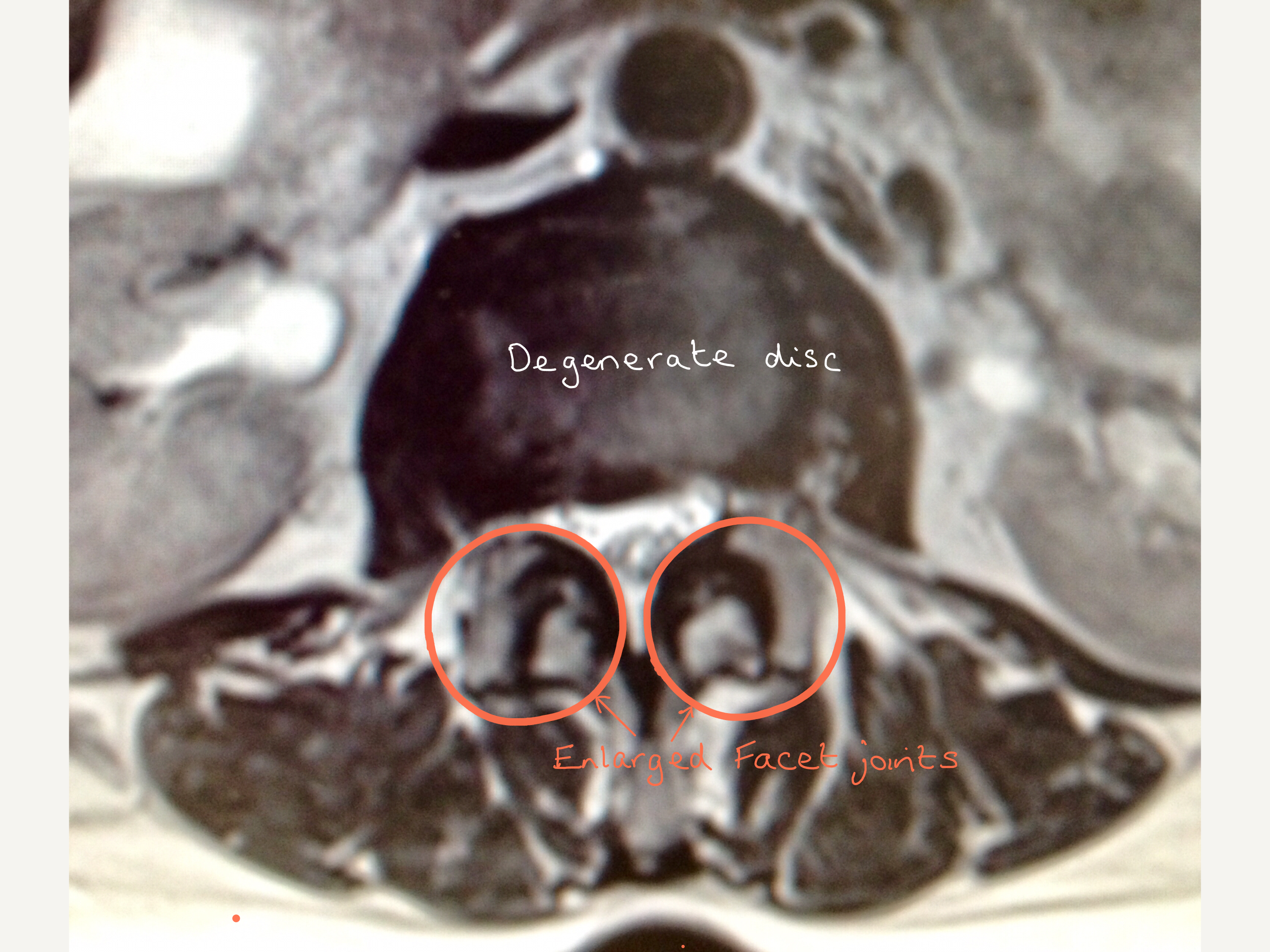What are facet joints?
The vertebrae in the spine and the intervertebral discs are surrounded by muscles which are called the ‘core muscles’. Between each vertebrae has a pair of joints which are mobile, interlock with each other and have some of the core muscles attaching to them; these joints are called the ‘facet joints’ (See the diagram). The facet joints slide over each other allowing the spine to bend and twist. Like all joints, both joint surfaces are coated with cartilage.
A small capsule surrounds each facet joint and provides a lubricant for the joint and contains nerve fibres called the ‘Medial Branch Nerves’ that send pain signals to the brain from the facet joints when there is irritation or inflammation.
What is Facet Joint Degeneration?
As a person gets older the discs start to lose water, their flexibility, their shock-absorbing characteristics and their shape (this is called ‘disc degeneration’ or ‘wear and tear’). As the disc degenerates, it becomes thinner and the disc height is lost and this puts more pressure on the facet joints which is demonstrated in the top MRI scan – this shows a degenerate L2/3 disc.
If the core muscles become weaker more pressure is put on the discs and facet joints. As a result, just like any other joint in the body, osteoarthritis (‘wear and tear’) of the facet joints occurs due to the joints becoming inflamed and enlarged (this is called ‘facet joint hypertrophy’) and the cartilage becoming thinner and less flexible.
The facet joints, which are circled, in the bottom MRI scan look big and bulky due to wear and tear (arthritis).
Facet joint degeneration is a common cause of back pain and stiffness and can happen anywhere in the spine however is most common in the low back (lumbar spine) and the neck (cervical spine) as these are the most mobile parts of the spine and therefore are most prone to wear and tear.
What are the symptoms?
Patients with low back pain due to facet joint disease commonly describe the back pain and stiffness as being at its worst first thing in the morning and it usually eases as they gets going and with exercise.
The pain is also usually exacerbated by sitting or standing too long.
Usually the low back pain is worse on extending the spine (bending backwards) more than bending forwards – this often referred to as “Extension Pattern Back Pain”.
The low back pain can radiate (spread) across the low back, over the hips, into the groins and down the thighs but very rarely goes past the knees. As a result facet joint disease can sometimes difficult to diagnose as the symptoms can be very similar to hip arthritis and pain originating from the spinal nerves.
Muscle spasms around the area of the facet joint degeneration causes episodes of sometimes severe pain and ‘locking’ of the back.


The diagram illustrates degenerative, inflamed facet joints which it makes easy to imagine why they can be so painful.


This is an axial (cross-section) image that shows what degenerative facet joints look like on an MRI scan. The joints are enlarged and inflamed.
Treatment Options
Painkillers
Painkillers (analgesia) such as ibuprofen, naproxen and meloxicam (NSAIDs) can help reduce the inflammation in the facet joints. If you are unable to take NSAIDs, paracetamol can be effective or consult your GP for advice. The use of strong opioids is not usually recommended; they are generally not effective in long term use and can be addictive. Many patients do not like taking regular painkillers, which is understandable, however regular painkillers can help facilitate regular exercise and physiotherapy.
Exercise
Regular exercise in the form of physiotherapy, Pilates, yoga, walking, swimming or whatever suits you most is essential – not only for long term relief of symptoms but also for the future protection and support of your spine. Regular exercise strengthens and conditions the core and postural muscles (the supporting muscles of the spine which act as an internal corset) and takes the pressure off the facet joints and helps ease the pain.
Weight Loss
Obesity or being over-weight places more stress and pressure on the facet joints. If you are over-weight, losing weight will help reduce the pressure on your facet joints and therefore may help reduce your back pain.
Injections
Despite regular exercise and painkillers, some patients continue to experience back pain due to facet joint disease. Steroid injections in the form of the Facet Joint injections or Medial Branch Blocks may help reduce the inflammation within the joint or around the facet joint nerves.
Facet Joint Denervation
Some patients get excellent results from facet joint injections or medial branch blocks but unfortunately the relief of symptoms is only short-lived and facet joint denervation may be considered. If successful, a denervation can be a long term solution to the pain.
Surgery
Surgery is not used for pure facet joint disease causing back pain when there is no associated leg pain or weakness (or arm pain/weakness).
However, surgery is considered when facet joints become enlarged (facet joint ‘hypertrophy’) or develop osteophytes (bony spurs) causing spinal stenosis which results in compression of the spinal cord or nerves causing leg (or arm) pain or weakness .
See Lumbar decompression.


